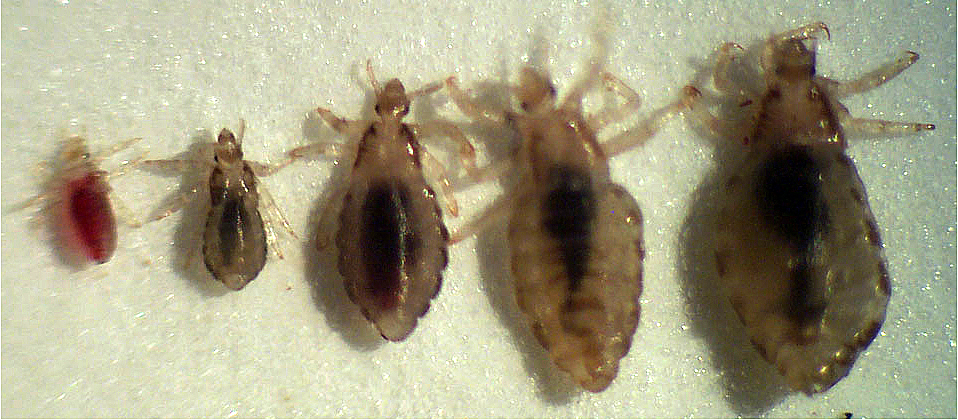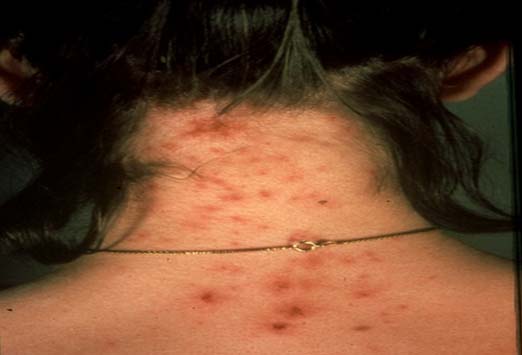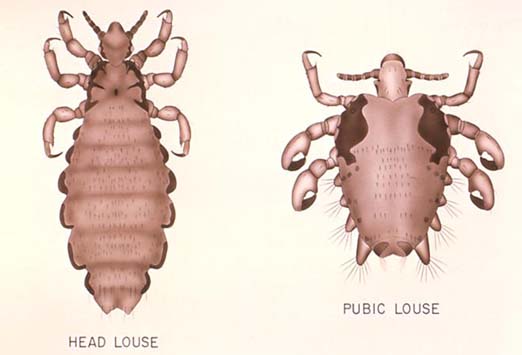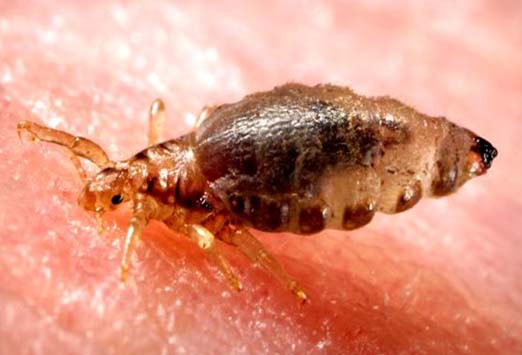Pediculosis

Lice are parasitic insects from the order Phthiraptera. Louse eggs are called "nits." Although lice are classified as either chewing or sucking, only the sucking lice purposefully affect humans. The 3 types of human lice are Pediculus humanus capitis (head louse), Pediculus humanus corporis (body lice), and Pthirus pubic (pubic louse, or "crabs"). All 3 types periodically feed on human hosts by piercing the skin and ingesting blood. "Pediculosis" refers to an infestation of lice and is a major problem in the United States.

Body lice infest clothing, laying their eggs on fibers in fabric seams. They typically affect homeless persons, who do not wash or change their clothes often. Body lice are a known vector of 3 major bacterial diseases: Rickettisa prowazekii, Bartonella quintana, and Borrelia recurrentis. Rickettsia prowazekii causes typhus and may produce epidemics during periods of overcrowded conditions and body louse infestations. Bartonella quintana causes trench fever, which was a major problem during World War I. Borrelia recurrentis causes relapsing fever, which is highly fatal among malnourished individuals.
Head and pubic lice both infest hair; they can be distinguished by their different body plans, notably the clawlike limbs on the pubic louse. Both organisms though lay their eggs on the base of hair fibers. Head lice are common in urban areas and spread easily because infected individuals are reluctant to share information with contacts owing to the social stigma associated with infestation. Pubic lice are generally spread through sexual contact and may be used as a marker of other sexually transmitted diseases. DNA extracted from pubic lice in victims of rape have been used to help identify perpetrators. Lice found on the eyelashes are typically pubic lice rather than head lice.

The most common symptom of infestation is pruritus, but children may be asymptomatic. On examination, patients with head lice may have occipital lymphadenopathy and impetigo. The scalp will show excoriations and dark specks of louse dung, nits, and adult lice. The most common site of infestation is the retroauricular scalp. Body lice are found on the seams of clothing; hemosiderin-stained purpuric spots on the skin are a cutaneous sign of infestation. Pubic lice are typically visible throughout the pubic hair. Pediculosis is diagnosed by direct visualization and identification of adult lice or nits. Louse bites may reveal intradermal hemorrhage and eosinophilic infiltrates on histologic examination.
 Treatment of lice infestation is typically approached as a community-wide problem; otherwise, reinfestation will reoccur. Fomite control by limiting the sharing of or contact between personal objects, such as combs, brushes, and clothing, is important. Pediculicides, such as permethrin or malathion, can be used to kill adult lice, but young nits do not have nervous systems and so are immune to neurotoxic agents. Specialty combs can help remove nits from hair follicles, as shown. For body lice, removal of infested clothing and laundering in hot water, ironing with a hot iron, or drying in a hot dryer are effective. Topical agents to be applied to clothing are also available.
Treatment of lice infestation is typically approached as a community-wide problem; otherwise, reinfestation will reoccur. Fomite control by limiting the sharing of or contact between personal objects, such as combs, brushes, and clothing, is important. Pediculicides, such as permethrin or malathion, can be used to kill adult lice, but young nits do not have nervous systems and so are immune to neurotoxic agents. Specialty combs can help remove nits from hair follicles, as shown. For body lice, removal of infested clothing and laundering in hot water, ironing with a hot iron, or drying in a hot dryer are effective. Topical agents to be applied to clothing are also available.
